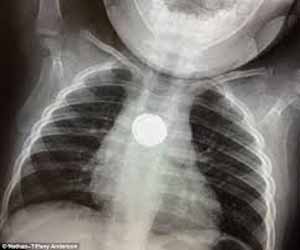- Home
- Editorial
- News
- Practice Guidelines
- Anesthesiology Guidelines
- Cancer Guidelines
- Cardiac Sciences Guidelines
- Critical Care Guidelines
- Dentistry Guidelines
- Dermatology Guidelines
- Diabetes and Endo Guidelines
- Diagnostics Guidelines
- ENT Guidelines
- Featured Practice Guidelines
- Gastroenterology Guidelines
- Geriatrics Guidelines
- Medicine Guidelines
- Nephrology Guidelines
- Neurosciences Guidelines
- Obs and Gynae Guidelines
- Ophthalmology Guidelines
- Orthopaedics Guidelines
- Paediatrics Guidelines
- Psychiatry Guidelines
- Pulmonology Guidelines
- Radiology Guidelines
- Surgery Guidelines
- Urology Guidelines
Increase witnessed in incidence of foreign body ingestions among young children

Increase witnessed in incidence of foreign body ingestions among young children, according to a new study. Young children explore the world by putting things in their mouths. While many of these items are relatively harmless, some can cause serious injuries and require immediate medical attention.The study has been published in Pediatrics.
A new study from researchers in the Center for Injury Research and Policy and the Division of Gastroenterology, Hepatology and Nutrition at Nationwide Children's Hospital analyzed data from the National Electronic Injury Surveillance System (NEISS) for children younger than six years who were treated in a U.S. emergency department due to concern of a foreign body ingestion from 1995 through 2015.
The study has found that more than 759,000 children younger than six years were estimated to have been evaluated for foreign body ingestions in emergency departments over the 21-year study period. The rate of foreign body ingestions per
10,000 children increased by 91.5%, from 9.5 in 1995 to 18 in 2015. The number of estimated cases among children under six nearly doubled from about 22,000, or about 61 per day in 1995 to nearly 43,000, or 118 per day in 2015.
Foreign body ingestions most frequently involved children between one to three years of age (62%). Coins were the most frequent type of objects ingested (62%), followed by toys (10%), jewelry (7%), and batteries (7%). Just over 10% of children were admitted to the hospital as a result of their ingestion.
While batteries represented only 7% of all cases, they can do considerable damage when ingested. This increase is of concern because battery ingestions increased 150-fold over the study period. Button batteries, found in everyday items like toys, key fobs, and greeting cards, represented 86% of battery ingestions.
"The dramatic increase in foreign body injuries over the 21-year study period, coupled with the sheer number and profundity of injuries is cause for concern," said Danielle Orsagh-Yentis, MD, lead author of this study and Pediatric GI Motility Fellow at Nationwide Children's Hospital. "Continued advocacy and product regulations are needed to keep children safe, and the data shows that vigilance, advocacy and regulations are effective."
Consumer groups, healthcare providers, and the Consumer Product Safety Commission (CPSC) have attempted to make toys, batteries, and magnets safer for children. Since 2008, the CPSC's Consumer Product Safety Improvement Act (CPSIA) requires manufacturers to take certain precautions in toys for young children including securing batteries and banning toys that fit in a choke-test cylinder. The American Academy of Pediatrics (AAP) has designed a task force to develop strategies to decrease button battery ingestions.
Recommendations for prevention of foreign body ingestions by both the AAP and the North American Society for Pediatric Gastroenterology, Hepatology and Nutrition (NASPGHAN) include:
Parents:
- Safe storage: Store small items, especially button batteries, high-powered magnets, and loose change up, away, and out of sight.
- Check the age recommendations: Labels on a toy's packaging can tell you if a toy is appropriate for your child's age. Read and follow manufacturer's instructions for assembly and use.
- How to get help: If you think your child may have ingested a foreign body, first call your pediatrician or poison control (1-800-222-1222). If you think your child may have ingested a button battery or high-powered magnet, go to your local emergency department as quickly as possible.
Advocates and manufacturers:
- Ensure child-resistant packaging is utilized and work to keep particularly dangerous products off the market.
Data for this study were obtained from the National Electronic Injury Surveillance System (NEISS) database, which is maintained by the US Consumer Product Safety Commission. The NEISS database provides information about consumer product-related injuries treated in hospital emergency departments across the country.
For more details click on the link: DOI: 10.1542/peds.2018-1988

Disclaimer: This site is primarily intended for healthcare professionals. Any content/information on this website does not replace the advice of medical and/or health professionals and should not be construed as medical/diagnostic advice/endorsement or prescription. Use of this site is subject to our terms of use, privacy policy, advertisement policy. © 2020 Minerva Medical Treatment Pvt Ltd